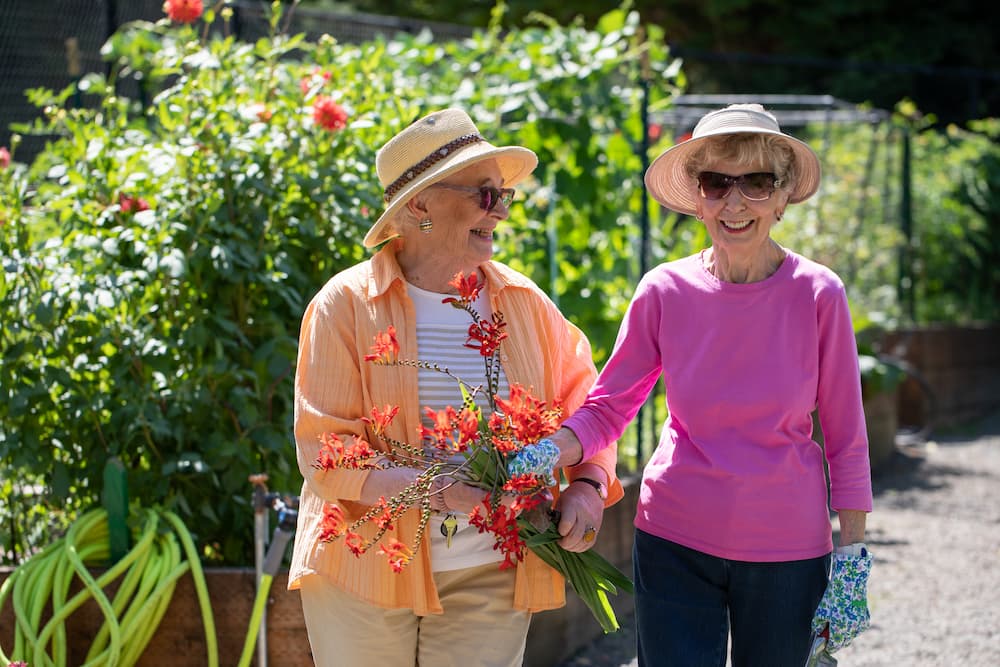
When it comes to nurturing your soul, gardening may not be the first activity that comes to mind. You may think of meditation or journaling or visiting a spiritual retreat. The truth is, though, nearly any activity you enjoy that brings you a sense of peace and contentment can help you “grow your soul.”
Gardening for the soul gives you the bonus of also growing beautiful flowers to feast your eyes on and delicious fresh fruits and vegetables to boost your nutrition—as well as physical, mental, emotional and quite possibly even social benefits.
As the medieval Persian poet Saadi wrote, “A garden is a delight to the eye and a solace for the soul.”
How Is Gardening Good for You?
Most gardens are outside (though you can derive many of the same benefits by gardening with houseplants, including an herb garden grown on your windowsill). Simply being outdoors in a natural setting—such as a garden, park or nature trail—can lift your spirits and bring a sense of calm.
Regularly spending time outside, taking in the fresh air and sunshine, can provide many potential health benefits, too, such as:
- Increasing serotonin levels, which can help prevent or ease depression and anxiety
- Lowering stress by decreasing cortisol levels
- Raising vitamin D levels, which can strengthen bones, teeth and muscles
- Aiding cardiovascular health by lowering blood pressure and heart rate
- Boosting immunity and energy levels
- Helping to lower the risk of cancer, osteoporosis and rheumatoid arthritis
- Improving sleep quality
With the variety of movement it entails, moderate-intensity gardening counts as whole-body exercise and has the potential to add these health benefits:
- Builds strength
- Improves flexibility and balance
- Increases manual dexterity
- Strengthens the heart and improves lung function
And There’s More!
Planting something, nurturing it and watching it grow can bring joy and a sense of accomplishment. This is true whether you grow flowers and other plants that add beauty to your surroundings or plants that bear fruits or vegetables.
Growing edible plants gives you the extra advantage of having fresh produce to enjoy, which can encourage better nutrition. You don’t need a plot of ground to grow vegetables and herbs. Many, including tomatoes, hot peppers, basil, chives and rosemary, will do quite well in a container garden on a patio if the conditions are sufficient.
Gardening Can Grow Social Connections, Too
Whether you’re a novice or you were born with a green thumb, you can find online gardening communities and other forums where fellow enthusiasts share tips and advice. As you search online, you might even come across a similar group right in your own neighborhood.
You might also find there’s a community garden nearby with space you can rent for a modest fee—or you may be able to volunteer at a community garden that provides produce for people in need.
Getting Creative With Gardening
Gardening is all about creating life, and it offers limitless opportunities to exercise your creativity.
It doesn’t matter whether you’re planning a verdant sanctuary in your backyard or a window box planter for your kitchen or balcony. You can find inspiration online or at your local nursery or garden center, and then create a little (or a lot of) garden art for the soul.
As you proceed through the planning stage and then begin working with seeds, seedlings (or bulbs) and soil, you may find that in addition to being soothing and comforting, gardening gives you something extra to look forward to as you watch your garden take shape and flourish.
Why Are Gardens Important for the Environment?
Planting a garden is one way to “go green” and show some kindness to Mother Earth. By absorbing carbon dioxide and then releasing clean oxygen, plants help clean the air.
Growing organic fruits and vegetables helps reduce the overuse of pesticides and chemical-laden fertilizers while providing healthier options for your meals and snacks.
When deciding what types of plants you want to include in your garden, you can choose a variety that will attract pollinators, including honey bees, hummingbirds and butterflies. This way, your efforts to help the environment will go well beyond your garden.
Adding a water fountain or birdbath to your garden can provide a mini oasis for feathered visitors—and increase your enjoyment as well!
You can also create an area in your garden for composting food scraps, which will enrich the soil and reduce what goes to the landfill.
These are just a few ways of gardening for good. You can find plenty of others through an online search, like this tip sheet for climate-friendly gardening from Washington State University.
Making Gardening More Accessible for Older Adults
Tending a garden can involve bending, squatting, twisting, stooping, reaching, lifting, carrying and other movements that older adults may find more challenging than when they were younger.
Fortunately, there are modifications and tools that can help gardeners continue to enjoy their preferred pastime well into their retirement years.
Raised bed gardens, for example, eliminate the need to squat or crouch down to ground level. For a patio garden, pots and planters can be placed on shelves or tables, making them easier to reach.
Using a gardening scooter, seat or kneeler, along with lightweight, ergonomic gardening tools designed for seniors will help keep the pleasure in gardening. If your local garden center doesn’t stock these items, you can order them online. This article from the Food Gardening Network offers some great suggestions.
A Garden for Gazing and Growing at Emerald Heights
One of our earliest residents was instrumental in establishing a garden area in our community more than 30 years ago. Although it’s been moved to another location on our campus, residents still can reserve a plot within the garden where they can grow nearly anything they want.
Like most other residents who have a plot in the garden here, Martha and Bob O’Keefe had a garden at their home before moving to our community more than a decade ago. Bob now chairs the residents’ garden committee and Martha keeps the group’s records.
Although the garden is enclosed with a mesh fence to keep deer and rabbits from making a meal of residents’ plants, it’s still quite visible. Throughout the growing season, you’ll find a broad array of plants in the garden, from showy roses and dahlias to peas, beans and rhubarb—and the ever-popular tomato plants, of course. A member of the residents’ bonsai group even has a plot in the garden for growing starter trees!
There’s a bench in the garden for anyone who wants to relax and admire the handiwork of their fellow neighbors. As Bob points out, it’s also a good spot for birdwatching and occasionally catching a glimpse of a deer passing by.
Having moved to Redmond from a more rural area in upstate New York, Martha says she is “intentional about getting into nature” because “it’s good for your health and well-being.”
In addition to the physical activity, Martha notes that gardening also benefits brain health because of the creativity and engagement it involves. There are other reasons she likes to garden, as well.
“I find just getting my hands in the dirt in the spring is good for my soul,” she says. “The harvest is rewarding, too.”
How the Garden Brings People Together
Bob and Martha both enjoy the social aspect of gardening, particularly the camaraderie of neighbors who are also working in the garden.
Because the garden is adjacent to our nature trail, people who are out walking on the trail often engage with the gardeners as they’re tending to their plants. This is a prime example of the many spontaneous opportunities residents have to meet others who live here.
Emerald Heights gardeners who are looking for a reliable source of advice can turn to Julene Wright , a master gardener living in our community who’s generous with her considerable knowledge.
In addition, our facilities staff is happy to help support the gardeners’ needs and maintain the overall garden, eliminating the literal and figurative “heavy lifting” for residents. For instance, the staff moves the compostable materials to the designated area, maintains the water supply to the garden and helps with the soil. Staff members also created the garden beds and built the enclosure.
Growing Beyond the Garden
As Martha notes, there are other opportunities besides the garden plots for residents to “get their hands in the dirt” here at Emerald Heights.
Our amazing garden railroad is a good example. Residents can volunteer to plant annuals in the garden railroad for the warmer seasons and prune the garden’s other plants to keep them at the right size for the railroad display.
There’s also the aforementioned resident-led bonsai group, which has proved to be quite popular since it was started a few years ago.
Another group is the resident landscaping committee, which collaborates with our facilities staff on landscaping projects for areas such as the chapel garden.
Last but certainly not least, residents are always welcome to grow their favorite plants in their homes, including on their patios and balconies—and many do!
Want to learn more about how Emerald Heights makes it easy for new residents to continue doing all they love to do? Contact us to schedule a visit or call (866) 822-0916.



